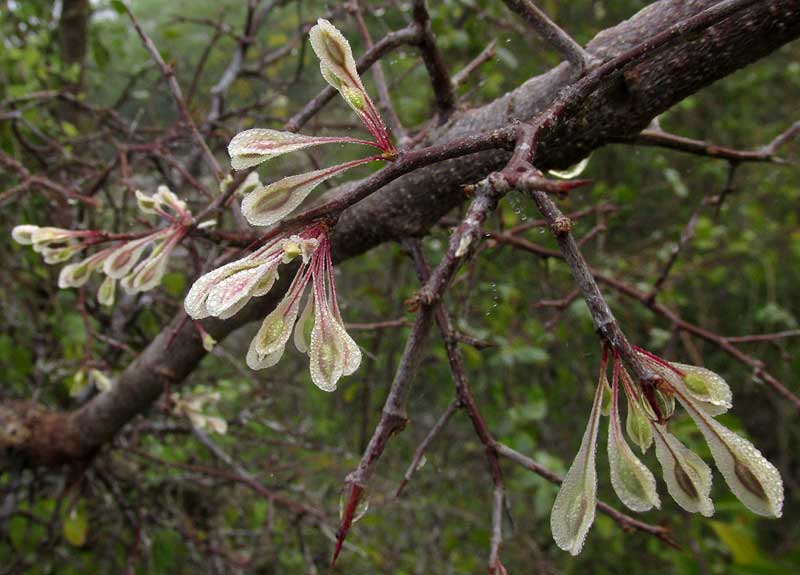Excerpts from Jim Conrad's
Naturalist Newsletter

from the March 15, 2015 Newsletter issued from Río Lagartos, on the Yucatan Peninsula's northern coast (~N21.60°, ~W88.16°), Yucatán state, MÉXICO
PODOPTERUS MEXICANUS
Nowadays deep in the dry season some woody plants that have lost all their leaves are flowering. Seeing such fresh, hopeful blossomings on wintry-looking trees and bushes fills one with a sense of spring. Above, you can see one such 10-ft-tall tree (3m).
I'd never seen what's shown in that picture, but at first glance I suspected that this tree, protecting itself with short branches that became sharp-pointed like big spines, was a member of the Buckwheat Family, the Polygonaceae. That's because the soft, three-winged fruits shown in the picture are structurally similar to those produced by the Buckwheat Family species known as docks (genus Rumex), whose springtime herbage often I have eaten in the North.
Knowing its family, it was easy to browse the list of Buckwheat Family members known to occur in the Yucatan, and realize that here we had the small tree known as PODOPTERUS MEXICANUS. The species is fairly commonly distributed in most of Mexico's arid thornforests and tropical evergreen forests, south into Costa Rica.
from the March 8, 2015 Newsletter issued from Río Lagartos, on the Yucatan Peninsula's northern coast (~N21.60°, ~W88.16°), Yucatán state, MÉXICO
PODOPTERUS MEXICANUS & THE HUMBOLDT/ BONPLAND EXPEDITION OF 1799 TO 1804
Meeting Podopterus mexicanus sent my mind into a tangent different from usual.
First of all, when I gave the Latin name, or binomial, as Podopterus mexicanus, I didn't provide the whole name. Technically, I should have included the "authority," which consists of the name or systematized abbreviation of the name of the person or people who first described the species to science. The most famous such authority is Linnaeus, known by the abbreviation L., as in the name Quercus alba L., for North America's White Oak.
The full name for our current plant is Podopterus mexicanus Humb. & Bonpl. The "Humb. & Bonpl." at the end refer to the authorities Friedrich Alexander von Humboldt (1769-1859) of Germany, and Aimé Jacques Alexander Bonpland (1773-1858) of France. Humboldt is the Humboldt of Humboldt Current fame, and I first grew interested in the Humboldt/Bonpland team when I read Humboldt's lengthy, detailed Reise in die Aequinoctial-Gegenden des neuen Continents, describing the expedition these men conducted into tropical America from 1799 to 1804. That adventurous trip was one of the earliest serious scientific expeditions made into the New World. The book describing the expedition, as well as other of Humboldt's books, some in English translation, can be freely downloaded at the Project Gutenberg site at http://www.gutenberg.org/ebooks/author/1995.
The book describes in detail the plants, animals, people and landscapes Humboldt and Bonpland encountered -- including some 60,000 plants that were, until then, mostly unknown in Europe. During the latter part of the trip, in 1803 and 1804, the men passed through Mexico. Bonpland was the main botanist, and did the drawings, but Humboldt was a good botanist, too.
Among the rare books at the Missouri Botanical Garden where I worked during the 1970s is Bonpland's 1808-09 publication entitled Plantes équinoxiales recueillies au Mexique : dans l'île de Cuba, dans les provinces de Caracas, de Cumana et de Barcelone, aux Andes de la Nouvelle Grenade, de Quito et du Pérou, et sur les bords du rio-Negro de Orénoque et de la rivière des Amazones. In that book Bonpland, in French and with an excellent drawing, introduces to the scientific world our currently prettily-flowering Podopterus mexicanus.
Bonpland writes that he and Humboldt discovered the plant near the village of Antigua, a little to the north, northwest of the port city of Veracruz, on the Mexican Gulf Coast. You can see Bonpland's illustration of the plant appearing in the book here.
At the above page you can continue to Bonpland's official Latin description of the plant, and his comments in French, by clicking a few times on the "NEXT" icon at the page's bottom.
Wikipedia's page for Alexander von Humboldt is at https://en.wikipedia.org/wiki/Alexander_von_Humboldt.
Bonpland's Wikipedia page is at https://en.wikipedia.org/wiki/Aimé_Bonpland.